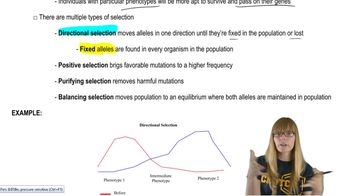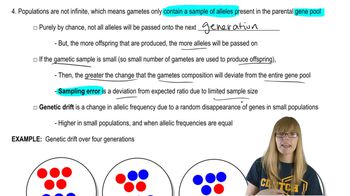Table of contents
- 1. Introduction to Genetics51m
- 2. Mendel's Laws of Inheritance3h 37m
- 3. Extensions to Mendelian Inheritance2h 41m
- 4. Genetic Mapping and Linkage2h 28m
- 5. Genetics of Bacteria and Viruses1h 21m
- 6. Chromosomal Variation1h 48m
- 7. DNA and Chromosome Structure56m
- 8. DNA Replication1h 10m
- 9. Mitosis and Meiosis1h 34m
- 10. Transcription1h 0m
- 11. Translation58m
- 12. Gene Regulation in Prokaryotes1h 19m
- 13. Gene Regulation in Eukaryotes44m
- 14. Genetic Control of Development44m
- 15. Genomes and Genomics1h 50m
- 16. Transposable Elements47m
- 17. Mutation, Repair, and Recombination1h 6m
- 18. Molecular Genetic Tools19m
- 19. Cancer Genetics29m
- 20. Quantitative Genetics1h 26m
- 21. Population Genetics50m
- 22. Evolutionary Genetics29m
21. Population Genetics
Allelic Frequency Changes
Problem 17
Textbook Question
A recent study examining the mutation rates of 5669 mammalian genes (17,208 sequences) indicates that, contrary to popular belief, mutation rates among lineages with vastly different generation lengths and physiological attributes are remarkably constant [Kumar, S., and Subramanian, S. (2002). Proc. Natl. Acad. Sci. USA 99:803–808]. The average rate is estimated at 12.2×10⁻⁹ per bp per year. What is the significance of this finding in terms of mammalian evolution?
 Verified step by step guidance
Verified step by step guidance1
Understand the context: The study examines mutation rates across different mammalian lineages, focusing on the constancy of these rates despite differences in generation lengths and physiological traits.
Identify the key finding: The mutation rate is estimated to be 12.2×10⁻⁹ per base pair per year, which is consistent across various mammalian species.
Consider the implications for evolution: A constant mutation rate suggests that genetic changes accumulate at a steady pace, providing a molecular clock for evolutionary studies.
Relate to evolutionary theory: This finding supports the neutral theory of molecular evolution, which posits that most evolutionary changes at the molecular level are due to random drift of mutant alleles that are selectively neutral.
Reflect on broader significance: The constancy of mutation rates can help in reconstructing evolutionary timelines and understanding the genetic basis of adaptation and speciation in mammals.
Recommended similar problem, with video answer:
 Verified Solution
Verified SolutionThis video solution was recommended by our tutors as helpful for the problem above
Video duration:
2mPlay a video:
Was this helpful?
Key Concepts
Here are the essential concepts you must grasp in order to answer the question correctly.
Mutation Rate
Mutation rate refers to the frequency at which changes occur in the DNA sequence of an organism's genome. It is typically expressed as the number of mutations per base pair per generation. Understanding mutation rates is crucial for studying evolutionary processes, as they can influence genetic diversity and adaptation in populations over time.
Recommended video:
Guided course

Mutations and Phenotypes
Molecular Clock
The molecular clock is a method used to estimate the time of evolutionary events based on the rate of molecular changes, such as mutations. By assuming a relatively constant mutation rate, scientists can infer the timing of divergences between species. The findings of constant mutation rates across different mammalian lineages support the reliability of the molecular clock in evolutionary studies.
Recommended video:
Guided course

Mapping with Markers
Evolutionary Implications
The significance of constant mutation rates across diverse mammalian lineages suggests that evolutionary processes may be more uniform than previously thought. This challenges the notion that generation length and physiological differences significantly affect mutation rates, indicating that evolutionary change may occur at a more predictable pace across species, influencing how we understand adaptation and speciation.
Recommended video:
Guided course

Overview

 5:58m
5:58mWatch next
Master Natural Selection with a bite sized video explanation from Kylia Goodner
Start learning




